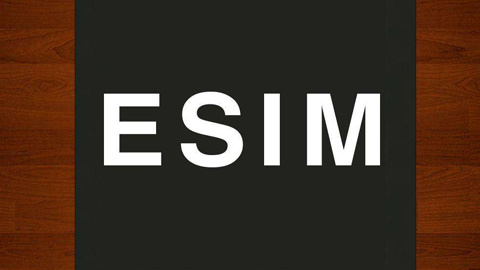eSIM in the field of the Internet of Things, mobile phones have not yet been seen

In previous years, the industry was still discussing whether eSIM would replace SIM. It seems too early to say a replacement.Recently, Beijing Mobile officially launched the "No. 1 dual terminal" business, eSIM once again attracted everyone's attention.
With the development of 5G and the Internet of Things, eSIM technology is rapidly landing in the field of the Internet of Things. However, the progress of the three major operators is different, at present, Telecom Unicom has achieved eSIM wearable device No. 1 dual terminal service has been expanded to the whole country, while China Mobile is still in the city after city opening.
But eSIM hasn't grown much on mobile phones. In previous years, the industry was still discussing whether eSIM would replace SIM. It seems too early to say a replacement.
eSIM has grown significantly in the field of the Internet of Things
eSIM, or embedded SIM card, is a traditional SIM card embedded directly into the device chip, users do not need to insert a physical SIM card, can directly access the wireless network services provided by the operator.
Internet of Things eSIM will be widely used in wearables, car networking, industrial Internet, smart cities and other fields. In Stratgy Analytics' forecast, eSIM sales for IoT applications will grow to $326 million by 2025.
Currently, consumer electronics, machine-to-machine (M2M) communications, and the Internet of Things (IoT) will be the three main applications for eSIM.
ABI Research, a market-adjusted agency, predicts that by 2024, there will be 644 million consumer electronics devices with eSIM built in, including about 500 million smartphones, and in M2M and the Internet of Things, eSIM devices are expected to reach 232 million (18 percent CAGR), of which more than 100 million will come from automobiles.
At home, in October 2020, the Ministry of Industry and Information Technology issued a document agreeing to China Telecom, China Mobile to carry out nationwide Internet of Things and other areas of eSIM technology application services.
At present, eSIM has made great progress in the field of chip.
Ziguang Guowei's eSIM chip has been used in some intelligent networking terminals, developed a "super eSIM" chip. It is understood that Ziguang Guo micro eSIM fully supports all GSMA (Global Mobile Communications Systems Association) standards from 3G to 5G, using the world's advanced manufacturing processes, performance improvement of 30%, with high safety, high reliability, high capacity and so on, support "more than one Terminals" new business form, in the form of packaging, it supports 5 x 6mm, 3 x 3mm, 2 x 2mm patch package and other sizes, as well as smaller size WLCSP packages, can be used for different types of terminals and applications.
Infineon also has a complete eSIM portfolio for consumer, industrial and vehicle regulation applications to meet the needs of different applications. For example, in the field of the Internet of Things, there are security controllers for industrial applications, including SLM76, SLM97, SLM17; In the automotive regulation field, there are safety controllers SLI76 and SLI97 for automotive applications.
Telecom Unicom has been pushed to the national mobile is still "under siege"
However, the progress of the three major operators is different, telecommunications Unicom has now achieved eSIM wearable device No. 1 dual terminal service has been expanded throughout the country, and China Mobile is still in the city after city opening.
China Mobile announced in June 2018 that its "eSIM 1 dual terminal" business was officially launched, and users can bind their phones to wearable devices and share the same number, phone bill and data plan through the "Double Terminal 1" service. The eSIM business pilot will be launched on January 23, 2019 in seven cities, including Tianjin, Guangzhou, Shanghai, Nanjing, Hangzhou, Shenzhen and Chengdu.
Currently, China Mobile 1 dual terminal service can use the eSIM feature on the Apple Watch. Supported areas include Beijing, Guangdong, Gansu, Jiangsu, Jilin, Liaoning, Shanghai, Sichuan, Tianjin, Zhejiang, and some cities in the above provinces and cities can already apply for eSIM.
In addition, eSIM business pilot cities have entered the official commercial, Shanghai Mobile in September 2020 began charging, Guangzhou Mobile from January 2021 began to charge. Currently charged according to the standard rate of 10 yuan/month.
China Unicom has been piloting eSIM wearable independence numbers and dual services in 7 cities in 6 provinces and 7 cities since March 2018, becoming the first operator in Chinese mainland to launch eSIM services; And from March 29, 2019, the country-wide launch of eSIM wearable independent number business, currently opened eSIM service smartwatch users have more than 500,000; On December 20, 2019, the Ministry of Industry and Information Technology officially approved the opening of a national service trial for China Unicom's eSIM wearable device No. 1 dual terminal service. So far, China Unicom has become the only operator in China to open eSIM independent number and no. 1 dual terminal dual service test, and is also the world's first operator with independent intellectual property rights eSIM management platform.
From January 1, 2020, China Unicom eSIM wearable device No. 1 dual terminal business will be expanded from the pilot to the whole country. On February 26, 2020, China Unicom and Guanghetong jointly released the world's first 5G-eSIM module.
In December 2018, China Telecom also opened eSIM 1 dual terminal service in Shanghai, Guangzhou, Shenzhen, Nanjing, Wuhan, Chengdu and Hangzhou. At present, has also opened in the country eSIM business, users can handle in the online office.
It is too early for eSIM to replace SIM
After many iterations, the mobile SIM card has been reduced from the once standard card size to the current size of 12.3 ×8.8mm, but as an information carrier, the nanoSIM card is still not proportional to the size of its internal chip. Therefore, eSIM cards are the future trend.
However, eSIM has not been a big development on mobile phones. Industry insiders say that because eSIM is embedded in the terminal, once the eSIM failure, basically can not be repaired, can only replace the terminal. From this point of view, it is not as convenient and secure as traditional SIM cards.
Moreover, eSIM is not just about designing and manufacturing a chip, it involves a whole set of systems, processes and support, which requires a certain period of time to be implemented step by step. Operators are also investing heavily, including platform construction and system retrofits. In previous years, the industry was still discussing whether eSIM would replace SIM. It seems too early to say a replacement.